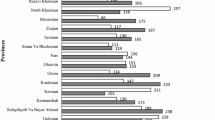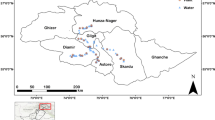Abstract
In Central Europe, the iodine content of weathered soils of new red sandstone, Muschelkalk, keuper and lower strata of new red sandstone, which developed from marine sediment is low. Boulder clays and diluvial sands also exhibit low iodine concentrations. In the same areas, the iodine concentration of drinking water decreases from 9 to 1 μg/l with increasing distance from the oceans. Cereals and foodstuffs produced from them are extremely iodine-poor. The iodine content of plants increases with the proportion of leaves. Soil contamination raises the iodine content of foodstuffs and improves the iodine supply of animals. The iodination of mineral mixtures increased the iodine content of cow's milk from 17 to 81 μg/l. The iodination of packed cooking salt and of the mineral mixtures for cattle and pigs resulted in a mean increase of the iodine intake of adults from about 30 μg/day to 48 and 59, respectively. Although iodine intake remained considerably below the calculated requirement for adults (100 to 150 μg/day), it led to the disappearance of Struma konnata and reduced the frequency of struma in children.
Similar content being viewed by others
References
Anke M, Arnhold W, Groppel B, Kräuter U, Müller M (1992) In: Brätter P, Gramm H-J (eds) Mineralstoffe und Spurenelemente in der Ernährung des Menschen. Blackwell, Berlin, pp 64–85
Anke M, Groppel B, Bauch K-H (1993). In: Delange F, Dunn JT, Glinoer D (eds) Iodine deficiency in Europe. Plenum Press New York London, pp 151–158
Anke M, Groppel B, Scholz E, Bauch K-H (1992) Mengen-und Spurenelemente 12:450–461
Anke M, Groppel B, Scholz E, Henning U (1994) Rekasan J 1:19–20
Anke M, Groppel B, Schwarz S, Kräuter U, Arnhold W, Jahreis G (1988) Mengen- und Spurenelemente 14:385–396
Anke M, Hennig A, Groppel B, Seffner W, Kronemann H (1982) Mengen- und Spurenelemente 2:395–406
Anonym (1973) Trace Elements in Human Nutrition. WHO Technical Report Series 532, WHO Geneva
Anonym (1974, 1980) Recommended dietary allowances — USA. National Academy of Sciences, Washington
Becker C, Delange F (1980) In: Stanbury JB, Hetzel BS (eds) Endemic goiter and endemic cretinism. Wiley, New York, pp 199–217
Groppel B (1988) Jodversorgung und Jodstatus des Wiederkäuers (Rind, Schaf, Ziege). Habilitationsschrift, Universität Leipzig
Gürtler H, Anke M (1993) In: Anke M, Gürtler H (eds) Mineralstoffe und Spurenelemente in der Ernährung. Media Touristik, Gersdorf, pp 1–13
Licastro F, Mocchegiani E, Zammotti M, Arena G, Masi M, Fabris N (1992) Int J Neurosa 65:259–268
Wada LL, Resyner-Cohen H, King J (1983) Fed Proc Fed Amer Soc Exp Biol 42:390
Author information
Authors and Affiliations
Rights and permissions
About this article
Cite this article
Anke, M., Groppel, B., Müller, M. et al. The iodine supply of humans depending on site, food offer and water supply. Fresenius J Anal Chem 352, 97–101 (1995). https://doi.org/10.1007/BF00322305
Received:
Revised:
Accepted:
Issue Date:
DOI: https://doi.org/10.1007/BF00322305




